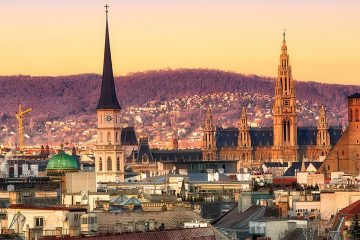Allow Vienna to Capture Your Heart
For the past eight years, Vienna has been named the city with the best quality of living in the world. Considered one of the most romantic destinations in Europe, Vienna has a lot to offer in terms of beauty.
Steeped in history, majestic architecture surrounds you in every direction. Day or night, you can enjoy the Danube River, which runs straight through the city and is dotted with cafes and restaurants.
Even if you tire of the city, a short bus ride will allow you to get in touch with nature in the Vienna Woods. Whether you’re only considering a trip to Europe’s cultural capital or have already booked your flight, take a look at our handy guide for Vienna tourism for a number of useful tips to help plan your stay.
What to Expect
In Vienna, and elsewhere in Austria, people primarily speak German. However, young people and those working in the travel or hospitality industries generally have a good grasp of English as well.
It’s still a good idea to learn a few key phrases to get by, especially “please,” “thank you,” directional words (like left and right) and various greetings.
Because it’s such a cultural city, there are a lot of colleges and universities in Vienna, so expect a lot of young people. That goes for children too, not just college-aged kids.
Kid-friendly Vienna has many places offering free entrance or travel to children under 12. In general, it’s also relatively safe for a big city, but common sense should always be used when traveling alone or at night.
Highlights
Widely considered a foodie city, you won’t just find wiener schnitzel in Vienna, although you should try the dish with some spaetzle at least once. A wide range of gastronomy is available including American-style sliders, Japanese food, vegetarian cuisine and of course German sausages.
Every trip to Vienna should include a visit to the Naschmarkt, which is full of a diverse array of restaurants, fresh seafood, produce and exotic spices.
Aside from excellent food, Vienna has been a prime hub for classical music since the 18th century and has produced some of the most famous composers in the world. Church concerts of Beethoven and Mozart pieces are very common all over the city.
There are also plenty of street musicians and performers, especially during festival season.
Aside from music, Vienna offers a wide range of cultural attractions including museums, opera, theater, palaces and gardens. Horse lovers will enjoy seeing the Lipizzaner horses at the Spanish Riding School where they perform a type of dressage called the “white ballet.”
The city also has one of the oldest zoos in the world, the Vienna Zoo, which is home to one of the few pairs of giant pandas outside China.
Where to Stay
Vienna’s quite budget-friendly, especially for solo travelers and families with young children. If you don’t mind sharing your space with other travelers, hostels are a great choice in Vienna.
Hostel dorm beds average at around $30 USD per night and some hostels also offer private rooms for couples or families at around $95 to $125 per night. Many hostels have special rates for guided tours and discounts for things to do in the area as well.
Some even have bars or biergartens on site and almost all offer a kitchen and common area.
Small budget hotels called “pensions” are also available for around $65 a night and usually include a private bathroom. Rooms are small, but most include breakfast, although WiFi may be extra.
Even four- and five-star hotels aren’t too pricey in comparison to other major European cities. Most range from $175 to $250 per night, which is excellent value for a family of four.
When you visit Paris you're sure to have a magical experience, soaking up the culture & dining on French delicacies. Here's how to make the trip a success!
Getting Around
Like most capital cities in Europe, Vienna is pretty easy to get around. Streets are small and condensed so everything’s essentially within walking distance. Local transportation includes buses and trams, which are quick and run frequently.
The city has an excellent underground subway system called the U-bahn that goes to every major attraction in the area. Buses, trams and subways generally cost the same amount, about €2.20 per journey.
Tickets can be purchased from U-bahn stations, Tabakladens (or tobacco shops, which are like small convenience stores) or you can purchase single rides on board any of the transports mentioned. Just don’t forget to validate your ticket!
For €8 to €9 you also can ride Vienna’s iconic Ring Tram, which goes around the center of the city.
When to Go
Vienna observes a summer break of sorts, called Sommerpause, during which some theaters, restaurants and small shops shut down temporarily. Therefore, to really get a feel for the city at it’s best, try to visit Vienna right before this break, in April or May, or right after in September or October.
During these months, temperatures range from the high 60s during the day to the low 40s at night.
April and May typically have a lot of spring festivals like the Vienna Blues Spring Festival or the culinary Genuss Festival. Although it does snow during the winter, a December visit is worth the chill.
There are a number of beautiful Christmas markets leading up to December 24, where you can find hand-crafted goods, delicious sweets and plenty of hot festive drinks.
